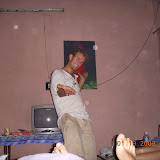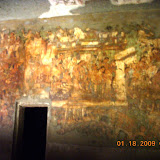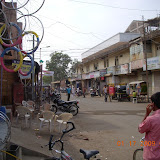Our bus to Aurungabad was an overnight sleeper. The seats were comfortable, and if you could ignore the Bollywood movie playing as entertainment you got a great nights sleep. The locals that were on the bus were very friendly, offering suggestions for sights to see as we traveled the country. When we got off the bus, we started the search for a hotel. It turns out that five Americans walking the streets of Aurungabad constitutes a parade. People stopped what they were doing to watch us, and children followed us waving, giggling, and yelling hello! We found a hotel in town that offered a 6 bed dorm room for the five of us for $12 per night. India is easy on the wallet.
We caught a bus for the Ellora caves; ancient Buddhist and Jainist temples carved out of the mountains near Aurungabad. The sight was amazing, and the experience was enhanced by the bizarre events of the day. Upon entering the sight, the first thing we saw was a family of monkeys. Fortunately we had some bananas handy, so we were able to make some new friends. As we ventured into the caves (cue the adventure music here) we we amazed at the detailed carvings and paintings covering the walls of the caves that are almost 1000 years old. The other tourist were mostly Indian nationals, who where happy to explain the different gods to us, in exchange for photographs. By the end of the day I felt like Brangelina and my cheeks hurt from smiling, but how can you say no to taking your picture with babies and primary school classes?
The next day the boys braved the streets of Aurungabad and rented bikes to get around town and see the sights. The roads in India are filled with trucks, cars, bikes, motorcycles carrying entire families, rickshaws, pedestrians, and livestock. There are no traffic lights, and lanes are optional. The trucks honk their horns through intersections to announce they are coming through, the rickshaws and motorcycles blow their horns to tell you to move out of the way, the pedestrians and bikes scramble to avoid all other traffic, and the cows do whatever they want, confident that all traffic will stop to let them pass. Terrified of the bikes, the girls stuck with the rickshaws. We managed to see the "mini-Taj Mahal" and the "Water Wheel" before hoping the bus to the town of Fardupur.
The local bus was a different experience from the tourist bus we had taken from Mumbai. On this bus we were loaded on early to ensure that we got seats, and a place to stow our luggage. During the journey, we talked to the locals sitting around us, and they allowed us to listed to their ipods and get a taste for the local music. At the rest stop outside of Fardupur, everyone filed off the bus and rearranged themselves so that we could be near the front for our stop. The driver, concerned that we would get lost, made a special stop near the town hotel. Instead of being annoyed with the inconvenience, people just smiled, waved, and bobbled their heads as the bus drove off. (The Indian head bobble is a unique thing. When ever they are happy Indian seems to bobble their heads from side to side like bobble heads. The expression is common and seems to be uncontrollable, like they are so happy they can't help it. It is adorable!)
The Ajunta Caves are in far better condition than the caves at Ellora. This means the paintings are more beautiful, but there are more people, and more restrictions on your movements as a result. We met a group of four young Indian women on the bus into the caves, and they offered to spend the day with us and act as our guides through the caves. It was helpful to have them around to explain the significance of the art. India is very religiously tolerant, and prides itself on being accepting of all religions. There were symbols in the caves representing most major religions, and a common image was that of four elephant bodies sharing one head. The idea is that the four elephants represent the major religions, all have different bodies, but all think with the same thought of honoring God. Pretty interesting.
We left Fardupur and the Ajunta Caves and headed north. We caught a bus to the big city of Jalgoan. As usual, the bus was stuffed to the limit. There was not room for our luggage, so they threw it on the roof, and we looked anxiously out the window at each turn expecting to see out luggage go flying. Instead, it was Leon who went flying off his feet as we rounded the first turn only to land in a heap on the three Indians crammed into the seat on his right. He felt terrible, but in typical Indian fashion they just laughed, offered to let him sit down, and then spent the next two hours trying to teach him Hindi. He was the most popular guy on the bus, and everyone was sorry to see him get off. One of his new found friends bought us a treat of paan when we got off the bus. We had no idea how to eat it, but thanked them just the same, and headed to the train station.
At the station in Jalgoan we bought tickets for the 1:30 am train to Wardha. We had two hours to kill, and we found ourselves a nice patch of sidewalk outside the station to wait it out. As we sat at talked we began to notice that we were attracting attention. First people were looking in our direction, and then slowly then started to move closer until eventually we were surrounded by a crowd of curious onlookers. Not quite sure what to make of it, we decided to try and find someone in the crowd who spoke English. Two men stepped up and took turns asking us questions and translating our answers to the crowd. Our friend Mike wears a charm necklace with charms collected during his travels. He saw a boy in the crowd with a similar necklace, and arranged a trade, one charm for another. Another man, gave Mike a bracelet to wear and insisted that he never remove it from him arm. We got a slew of e-mail addresses, and phone numbers, and were told that we were invited to dinner and tea the next time we came through town. Finally the crowd got so big that it attracted the attention of the local police. They asked us to please sit in the first class waiting area to avoid blocking traffic. :)
When the train finally arrived, we were dismayed to find that there were no seats available for our overnight journey. One ticket-taker suggested that we get off at the next stop, and head down to the sleeper car section where we could pay extra for a bed. We willingly went from car to car, only to find that there were no sleepers available either. We ended up sitting on the floor, near the doors, using our backpacks as cushions the entire night. We managed a few hours sleep, but our first order of business after arriving in Wardha was to find a hotel and crash.
From Warha, we headed 9km south to the town of Sevegram. Located there is the ashram founded by Gandhi, and the base for his peaceful resistance movement. The ashram is still functioning today, and they allow visitors who are interested in learning about Gandhi and his teachings to stay a few days, living the life of the ashram follows. We moved to Sevegram the next morning, and stayed for three nights. The schedule was as follows: Wake up at 4:30 for morning prayer. Yoga from 5:30-6:30 followed by an hour of community cleaning. At 7:30 we ate breakfast, and then we had an hour of free time and two more hours of community work before lunch. After lunch we rested until 3, worked for two more hours, until dinner at 5. Evening prayer was at 6 and then lights out around 9. The boys spent their work hours in the fields, helping to plant an organic garden, and the girls worked in the kitchen, cleaning grain and helping to serve meals. During our free time, we took naps, did laundry, or bathed using buckets of water set out in the sun to warm. There was an old woman at the ashram who had attended school there as a child, and was a teenager during Gandhi's final years there. She would sit with us in the afternoons and tell us stories about the man and his mission, and about life on the ashram. After three days, the schedule was beginning to wear on us, and we decided to move on. We left to head toward Goa and the beach, and our second week in India.
 |
| Wardha |
 |
| Ajanta Caves |
 |
| Aurungabad |
 |
| Mumbai |

1 comment:
Sara, this is really fascinating. Glad to see you guys aren't having any issues. Will be looking for the next installment
Post a Comment